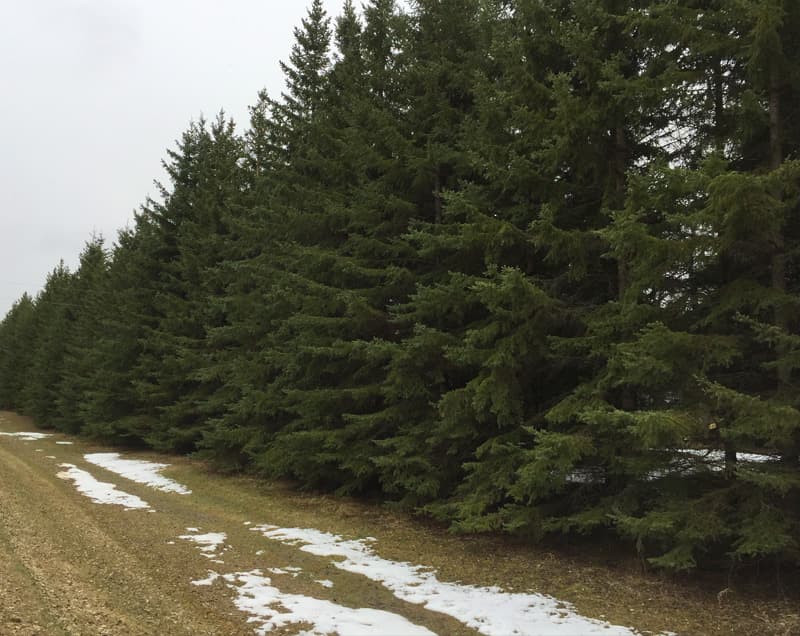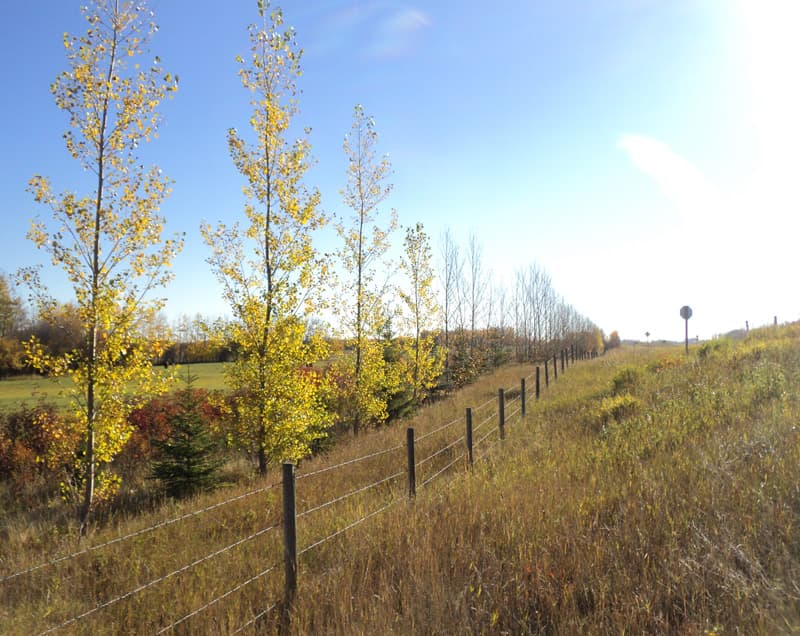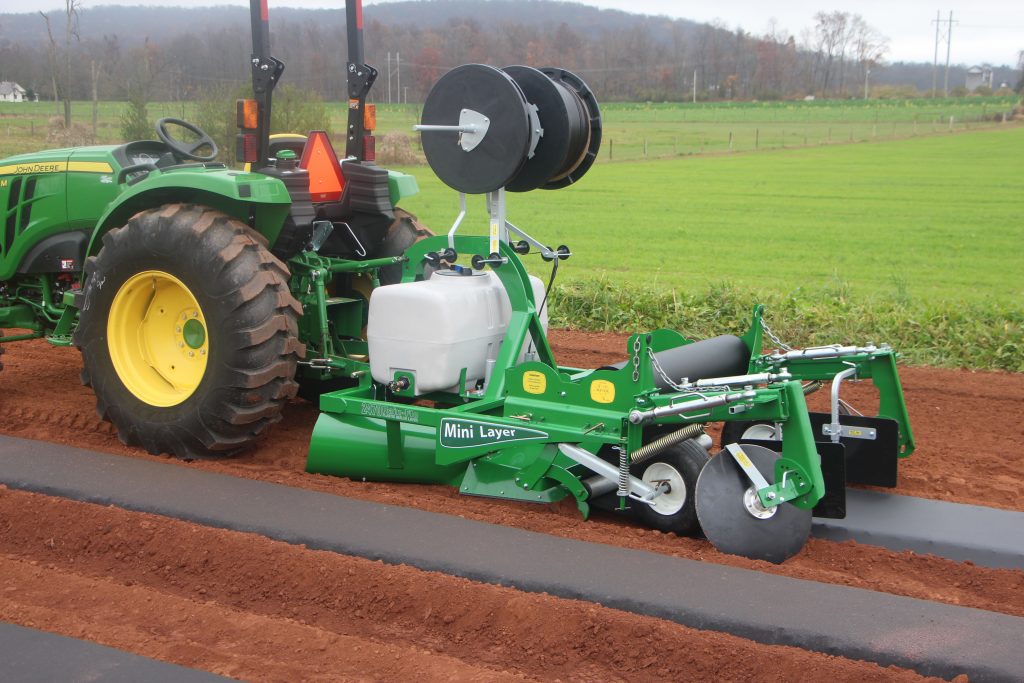The Many Benefits of Shelterbelts
Long rows of stately trees add beauty to many farmsteads and acreages. These shelterbelts provide many additional services as they shelter yard sites and livestock, conserve soil, trap snow, protect water quality, bear fruit, and provide wildlife habitat.
Traditionally, shelterbelts were multiple straight rows of trees lining a driveway or bordering farm fields. Ecobuffers, established using different planting configurations, bring additional benefits for environmental conservation.
Thinking of starting a shelterbelt? Contact County Horticulturist Lorraine Taylor for information on suitable species, shelterbelt design, planting recommendations and more.
Planning and Planting
Establishing a shelterbelt can be a big investment in time and money. Success depends on close attention to design, plant selection, site preparation, proper planting, early establishment maintenance, and long-term care. Careful planning improves the benefits and helps avoid problems.
Placement of trees and Municipal Bylaws
When planting near a property line, trees should be set back at least a distance equal to half of the expected mature spread. Lac Ste. Anne County has the right to remove any overhanging branches from the ditch in the county owned right-of-way. Per Land Use Bylaw No. 24-2014, when planting on a corner site (e.g. where a range road and township road meet) a specific set-back applies to preserve a sight triangle at the intersection.
Click Here to view a PDF of the shelterbelt portion of Land Use Bylaw No. 24-2014.
Plant Stock
For more than 100 years the federal shelterbelt program provided trees to agricultural landowners through the Prairie Farm Rehabilitation Administration (PFRA). Counties across the province participated in the PFRA program, each spring distributing thousands of seedling trees to landowners. There are many fine examples of mature shelterbelts in Lac Ste. Anne County.
Plants used for shelterbelts includes trees and shrubs. With the closure of the PFRA program in 2013, several nurseries increased their offering of shelterbelt seedings of native and introduced species.
Shelterbelt Tree Seedlings
A partial list of private tree nurseries selling shelterbelt tree seedlings to Alberta residents is shown below. Click the various links to explore their websites where you'll find plant descriptions, planting and care information, and more.
Private Tree Nurseries Selling Shelterbelt Tree Seedlings
Boreal Horticultural Services Ltd.
Address: Box 5021 Bonnyville AB T9N 2G3
Website: borealhort.com
Phone: 780.826.1709
Email: boreal@mcsnet.ca
Sherwood's Forests
Address: 50042 Range Road 31, Warburg AB T0C 2T0
Website: sherwoods-forests.com
Phone: 780-848-2548
Email: sfinfo@sherwoods-forests.com
HELP International Shelterbelt Centre
Address: P.O. Box 181, Queen Street City Farm, Weyburn, SK S4H 2J9
Website: help-shelterbelts.com
Phone: 306.861.0814
Email: helpint@sasktel.net
Tree Time Services Inc.
Address: 3464 78 Avenue NW, Edmonton AB T6B 2X9
Website: treetime.ca
Phone: 1.844.873.3700
Email (Sales): Sales: sales@treetime.ca
Email (Support): support@treetime.ca
Prairie Shelterbelt Program
Address: P.O. Box 1930, Sundre AB T0M 1X0
Website: prairieshelterbeltprogram.ca
Phone: 403.507.8340
Fax: 403.507.2336
Email: trees@prairieshelterbeltprogram.ca
Black Plastic Mulch
Plastic mulch is a very effective way to control weeds within shelterbelt tree rows. Following thorough soil preparation, the heavy plastic mulch can be laid down by hand in small plantings or be installed with a tractor-pulled mulch applicator for large projects. The plastic mulch gives seedling trees a good chance to establish without weed competition. It also improves growth by conserving soil moisture and stimulating root growth by warming the soil.
Weed control prior to planting and in the early years after planting is key for trees to thrive. Black plastic mulch increases the success rate of shelterbelt establishment by controlling weeds and conserving moisture. Rolls of mulch are available for purchase from the County- 2.7 ml thick x 4’ wide x 1,500’ long (whole rolls only).
Click Here to view guidelines from Agriculture and Agri-Foods Canada for how to install plastic mulch.
Plastic Mulch Applicator – for shelterbelt trees and horticulture crops
Rain-Flo Plastic Mulch Model 2470 Mini Layer
Rental Fee: $100.00/day (plus GST) plus $500.00 damage deposit
Rental fee is waived when used for tree planting.
When rental equipment is returned in acceptable condition, the damage deposit is returned in full.
Starting with prepared soil, the machine forms the bed, puts down a single drip tape, lays mulch, and covers the edges of the mulch, all in one operation. The finished bed is about 30” across the top and can be adjusted to form 3-5” raised beds. Many types of mulch plastic can be used.
Equipment specifications: https://www.rainfloirrigation.com/equipment/raised-bed-layers/model-2400
- Will Lay 4’ Plastic w/ 56” Minimum Row Spacing
- Adjustable 3” – 5” Bed Height
- Requires Minimum 40 HP w/ 4-Wheel Drive Tractor
- Adjustable Weight w/ Water Tank for Firmer Press Bed
- Compact Machine for High Tunnels & Small Tractors
- Adjustable Tension Brake on Plastic Roll Carriers
- Replaceable, Reversible Plow Shares
- ⅜” & ½” UHMW Poly Lined Bed Press
- Category I & II 3-Point Hitch
- Single drip irrigation tape attachment
- Center Bed Filler (for heavy soils)
Other Great Shelterbelt Resources
Alberta Agriculture and Forestry
- R3 Shelterbelts for Livestock Farms in Alberta: Overview (guidelines)
- R4 Shelterbelts for Livestock Farms in Alberta: Planning, Planting and Maintenance (guidelines)
- R5 Shelterbelts for Livestock Farms in Alberta: Shelterbelt Planning Workbook (guidelines)
- R6 alberta.ca/horticulture-publications.aspx
Agroforestry and Woodlot Extension Society
Publications on design, ecobuffers, planting for pollinators, riparian projects and site preparation.
Agriculture and Agri-Food Canada
Shelterbelt Funding Resources
Funding for agricultural producers for some shelterbelt and eco-buffer projects is available from the Canadian Agricultural Partnership (CAP) program under the Environmental Stewardship and Climate Change – Producer section. Agricultural Input and Waste Management (C)· Shelterbelts and Eco-Buffers (304)
For details on eligibility, please visit the CAP Website, call Call 310-FARM (3276)
or email af-gfstewardship@gov.ab.ca.
Please Note: A valid Alberta Environmental Farm Plan (EFP) is a prerequisite to this program. EFP has implemented a 10-year renewal starting 2018; therefore, an EFP completed more than 10 years before your application date will not be considered valid.












